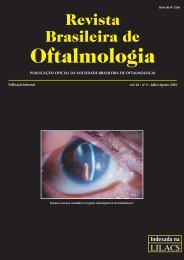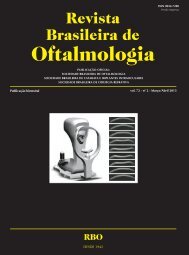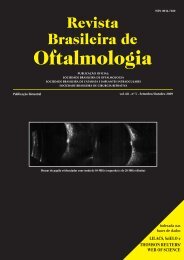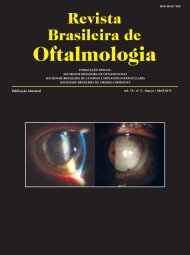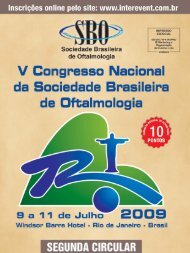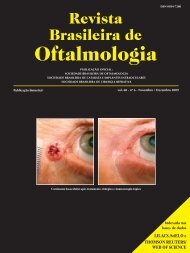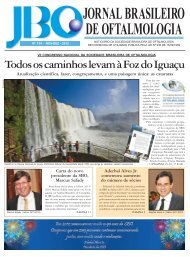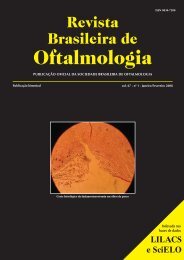Jul-Ago - Sociedade Brasileira de Oftalmologia
Jul-Ago - Sociedade Brasileira de Oftalmologia
Jul-Ago - Sociedade Brasileira de Oftalmologia
- No tags were found...
Create successful ePaper yourself
Turn your PDF publications into a flip-book with our unique Google optimized e-Paper software.
Comparison between OPD-scan results and contrast sensitivity of three intraocular lenses: spheric AcrySof SN60AT ...217INTRODUCTIONWavefront science has helped explain that this<strong>de</strong>cline occurs because of increasingspherical aberration of the human lens (1-3) ,New possibilities appeared when new technologies were<strong>de</strong>veloped, like the wavefront analysis using theHartmann-Shack aberrometer and the optical pathdifference scan (OPD-scan), which measures the distancelight travels in different paths going through the eye,measuring the optical system aberration (2,3) . Theintegration of wavefront technology and lens-basedsurgery represents a step toward improving functionalvision and the quality of life for cataract patients (2-6). Aswe have learned that the optical wavefront of the cornearemains stable throughout life, the lens has started tocome into its own as a primary locus for refractivesurgery (7) .The evolution in cataract surgery has evolved withnew surgical techniques, instrumentals, viscoelastic<strong>de</strong>vices and IOL <strong>de</strong>signs that provi<strong>de</strong> high-qualityoptical imagery at all focal distance, since the first use ofthem by Ridley (1) . What remains is a challenge for opticalscientists and material engineers to <strong>de</strong>sign a IOLs thatcompensate for any aberrations inherent in the cornea.The multifocal IOL try to minimize loss of inci<strong>de</strong>nt lightto higher or<strong>de</strong>rs of diffraction, reducing opticalaberrations, and balancing the brightness of the focusedand unfocused images (8) .In the AcrySof ® SN60D3 Restor ® IOL, the logicof placing the diffractive element centrally <strong>de</strong>pends onthe near synkinesis of convergence, accommodation, andmiosis. As the pupil constricts, the focal dominance of thelens shifts from almost purely distance to equal-parts’distance and near. This approach conserves efficiencyfor mesopic activities when the pupil is larger, such asnight driving, but reduces near vision un<strong>de</strong>r mesopicconditions (6) .Contrast sensitivity testing has confirmed a <strong>de</strong>clinein visual performance with age (6-10) . Improvements inocular biometry and cataract surgery have minimizedrefractive error, promoting quick visual recovery, withlow intraoperative complications, good postoperativequality of functional vision, more accurately <strong>de</strong>scribedon the basis of the ability to precisely discern <strong>de</strong>tailsof images regardless of lighting and brightnessconditions (7,11) .The purpose of this study is to compare theaberrometry results with OPD-scan and contrastsensitivity in patients who had implantation of theAcrySof SN60D3 multifocal IOL, the AcrySof SA60ATspheric monofocal IOL and the AcrySof SA60ATaspheric monofocal IOL in cataract surgery.METHODSThis prospective, randomized study comprised 96eyes of 48 patients selected between march 2005 andjuly 2006. This study was conducted according toestablished ethical standards for clinical research andthe internal review board of our hospital approved thestudy protocol.Inclusion criteria was age between 45 and 75 yearsold, presence of cataracts, classified by the Lens OpacitySystem II (LOCS II), and corneal astigmatism less than1.00 diopter in both groups, with no other ocularpathologies, no previous ocular surgery or use of topichipotensive medication and pupil diameter of at least 3.5mm or more un<strong>de</strong>r mesopic and photopic light conditionsas measured by the Colvard pupillometer (Oasis,Glendora). In addition, all patients with systemic diseasepotentially affecting vision or specifically affectingcontrast sensitivity, such as diabetes retinopathy, wereexclu<strong>de</strong>d. Patient with intraoperative or postoperativecomplications, including lens fixation that could not beclassified as ‘‘secure and in-the-bag’’ or lens <strong>de</strong>scentrationgreater than 0.5 mm were not inclu<strong>de</strong>d in the study.A standard ophthalmic evaluation, performed inall visits, which inclu<strong>de</strong>d distance (6m), intermediate(70cm) and near (33cm) best corrected and uncorrectedvisual acuity, biomicroscopy, intraocular pressuremeasurement and fundoscopy. The patients wererandomized, using the Randomizer ® program, into oneof three groups for IOL implantation as follows: sphericmonofocal group, AcrySof ® Natural ® (SN60AT, AlconLabs), aspheric monofocal group, AcrySof ® Natural ® WF(SN60WF, Alcon Labs) and multifocal group, AcrySof ®Restor ® (SA60D3, Alcon Labs).All patients IOL calculation were done byimmersion ultrasonic technique by single experience<strong>de</strong>xaminator (A.F.P.M.) using the Ocuscan RXP biometer(Alcon Labs), and the IOL power selected with Hoffer-Q or SRK/T formulas according to measured eye axiallength (12) . Target refraction was plano (0D), or the firstpositive value for the multifocal group and targetrefraction was plano (0D), or the first negative value for thespheric and aspheric monofocal group.Pupil diameters were Ginsburg box phtometer(85 cd/m 2 and 6 cd/m 2 ) by means of a Colvardpupillometer (Oasis, Glendora). All subjects un<strong>de</strong>rwentRev Bras Oftalmol. 2009; 68 (4): 216-22



